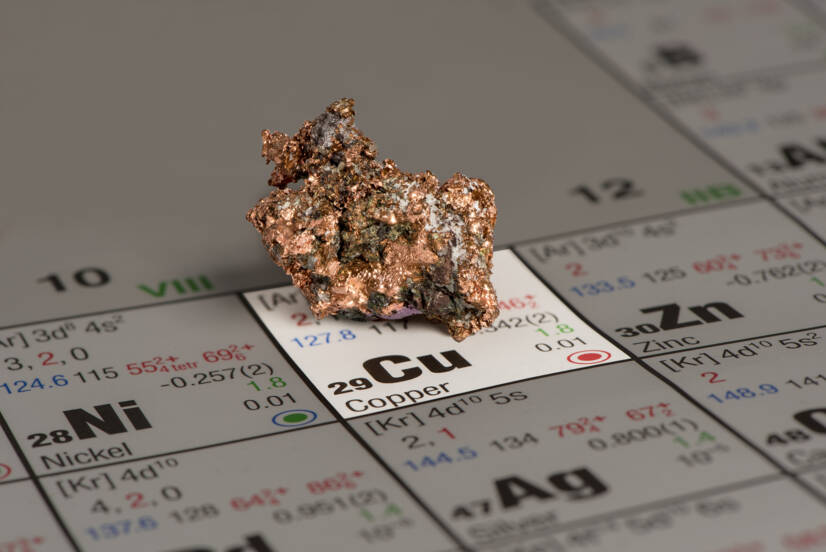- pubchem.ncbi.nlm.nih.gov - Copper
- ncbi.nlm.nih.gov - Trace elements in human physiology and pathology. Copper, H. Tapiero, D.M. Townsend, K.D. Tew
- longdom.org - Copper and Zinc, Biological Role and Significance of Copper/Zinc Imbalance, Josko Osredkar, Natasa Sustar
- prolekare.cz - Biological role of copper as an essential trace element in the human organism, M. Pavelková, J. Vysloužil, doc. PharmDr. Kateřina Kubová, Ph.D., D.Vetchý
- ncbi.nlm.nih.gov - Copper: an Essential Metal in Biology, Richard A. Festa, Dennis J. Thiele
- multimedia.efsa.europa.eu - Dietary Reference Values for the EU
Copper: Effects on the human body. Why is it important? What principles of intake should be followed?

Copper and its effects on the human body. Why is it important and what principles apply to its intake?
Article content
- What do we know about copper?
- What are the medical uses of copper?
- Do you know the biological function of copper?
- Copper - from intake to excretion
- What are the dietary sources of copper?
- What is the recommended daily intake of copper?
- Disorders of copper homeostasis in the body
- What are the consequences of copper deficiency?
- What are the consequences of copper excess?
- Inborn errors of copper metabolism
What do we know about copper?
Copper is a naturally occurring element. It is present in trace amounts in our environment, most commonly in soil, vegetation, water and the atmosphere.
It is known by the chemical name Cu, which is derived from the Latin word cuprum. This Latin name comes from the name of the island of Cyprus, as this is where copper was first mined.
Copper is an element of group 11 of the periodic table of chemical elements and is found in the 4th period.
It is one of the noble metals, as are the other elements of this group - gold and silver.
In its pure form, copper is coloured reddish-brown with a bright metallic lustre. It is one of the few metals whose natural colour is other than grey or silver.
It is soft, malleable and ductile. It has high thermal and electrical conductivity (second highest after silver).
It does not react with water. However, it reacts with oxygen in air by a slow reaction to form a layer of brown copper oxide, which protects copper from corrosion.
After a few years, a green layer of copper oxide begins to form on the surface of the copper. This can often be seen on older copper structures, an example being the Statue of Liberty.
A tabular summary of basic chemical and physical information about copper
| Name | Copper |
| Latin name | Cuprum |
| Chemical name | Cu |
| Classification of elements | Noble metal |
| Grouping | Solid |
| Proton number | 29 |
| Atomic mass | 63,546 |
| Oxidation number | +1, +2 |
| Melting point | 1084,62 °C |
| Boiling point | 2562 °C |
| Density | 8,933 g/cm3 |
In nature, copper is one of the few metals that occur in their natural form - pure and directly usable.
It also occurs as part of many minerals in the form of copper sulphides (chalcopyrite, digenite, bornite, covellite, chalcocite), sulphosols (enargite) and copper carbonates (azurite, malachite).
The fact that copper occurs in its original form is also the reason why it was known and used by the earliest civilisations. The history of copper use dates back to 9 000 BC.
The largest copper deposits are found in Chile, the USA, Peru, Zambia and the Congo.
Copper for industrial purposes is extracted primarily from copper ores and secondarily through a recycling process.
Currently, copper is mainly used in the electrical industry (as a component of wires and cables), where its conductive properties are exploited.
It is used in the manufacture of coins, jewellery, water pipes, in metallurgy for the production of alloys (bronze, brass) and in architecture.
It is also a component of agricultural products (fertilisers, feed additives) and wood preservatives (anti-fungal properties). It is used to purify water (from algae) or as a pigment.
What are the medical uses of copper?
In medicine, copper finds a really wide range of uses, mainly due to its effects against bacteria, moulds, mites and also due to its disinfectant properties.
It is therefore used as a component of many medical materials, devices, preparations, etc.
We can give several examples of copper's use in the medical field:
- Part of a covering with antibacterial effect for wound healing
- Gynaecology - intrauterine devices with contraceptive effect
- Dentistry - part of dental cement, production of bridges and crowns
- Composition of nasal sprays with disinfectant effect
- Treatment of rheumatoid arthritis
- Disinfection of areas, surfaces or clothing in healthcare facilities - prevention of nosocomial infections
- Component of textiles - socks to prevent fungal infections as well as mattresses, mattress pads, pillows or carpets with an anti-mite effect
- Cosmetic creams and ointments
- Component of surfaces and packaging in the food industry (food preparation, storage, transport)
- Respiratory masks with antiviral effect
In the past, copper was used in Egypt and Syria as an anti-parasitic, anti-vomiting or astringent agent.
Do you know the biological function of copper?
Copper is the third most abundant trace element in the human body after iron and zinc.
It is found in the body mainly in the oxidized form of Cu+2 - copper ion or, to a lesser extent, in the reduced form of Cu+1.
It plays an important role in many physiological and biochemical processes of the organism as a cofactor of key enzymes.
These enzymes are also involved in a large number of enzymatic processes in the body - they catalyse them.
These include cellular respiration, the production of neurotransmitters and peptide hormones, protection against free radicals or the proper function of elastin, collagen and keratin.
Other important functions of copper in the human body:
- It is important for maintaining iron homeostasis, thus indirectly contributing to blood formation and clotting.
- It maintains the strength of the skin, connective tissues and blood capillaries.
- It contributes to the function of the innate immune system.
- Maintains normal thyroid function.
- Due to its ability to accept or give up electrons, it contributes to the scavenging of free radicals. It has antioxidant and, in turn, pro-oxidant properties.
- It is a powerful antimicrobial agent. It has antibacterial activity against Staphylococcus aureus, Escherichia coli, Pseudomonas aeruginosa, Enterococcus faecalis and Bacillus subtillis.
- It also has antiviral effects against bronchitis virus, herpes simplex.
- It can also kill sperm.

Copper - from intake to excretion
Copper is an essential trace element. It is essential for life but can also be toxic.
Regulation of its levels in the body is therefore necessary and essential. Homeostatic mechanisms are involved that regulate the uptake, distribution, retention and excretion of copper.
Absorption
Copper enters the body mainly through food.
Absorption occurs in the environment of the small intestine and to a small extent in the stomach, either by diffusion (especially at high copper concentrations) or via transport proteins (at low copper concentrations).
The amount of copper absorbed into the body depends on the presence of copper in the diet. In normal intake, 55-75 % of the copper in the diet is absorbed.
The absorption of copper in the gastrointestinal tract depends mainly on its chemical form. Cu+2 ions are reduced to Cu+1 in the intestinal cells because only in this form are they able to pass through the cells.
The absorption of copper can also be influenced by certain dietary components.
These substances can reduce the solubility of copper and thus its bioavailability. We are talking, for example, about fibre, phytates, vitamin C or certain sugars. There is a risk of reduced copper absorption only if they are taken in excessive quantities.
Some food components compete with copper for binding to transport proteins, such as zinc and cadmium.
Conversely, copper bioavailability is increased by high protein intakes.
Distribution and metabolism
Once absorbed into the bloodstream, copper is rapidly distributed to the sites where it is needed (especially for enzyme production).
Its distribution from blood cells is controlled by a protein known as ATP7A or Menkes protein. Copper is transported from blood cells by binding to the transport protein albumin, transcuprein or amino acids.
Due to its highly reactive nature and risk of damage to the body, copper is not found in cells as a free ion, but always in a bound form.
The Menkes protein distributes copper to the Golgi apparatus (where it forms protein enzymes) and, in the case of increasing concentrations, to the pellets.
The pecenum is the main storage organ for copper.
Menke's protein also plays a key role in the transport of copper across the placenta and the blood-brain barrier. This is essential for the development of the baby (especially the brain).
Copper binds to the protein ceruloplasmin in the liver and is released into the bloodstream. This process of binding and release into the blood is again controlled by a protein known as ATP7B or Wilson's protein.
Approximately 90% of the copper in the blood is bound to ceruloplasmin. It is ceruloplasmin that is then responsible for transporting the copper to the tissues where it is needed.
The total copper content in the body is approximately 70-80 mg. 10% of this amount is in the blood and 90% in the tissues.
Under normal conditions, the highest concentrations of copper are in the bile, liver, brain, heart, bones and kidneys.
Blood copper levels vary slightly by sex, ranging from 0.614 to 0.970 mg/l in men and increasing with age, and from 0.694 to 1.030 mg/l in women.
Excretion
Regulation of copper excretion is the main mechanism for maintaining homeostasis and physiological levels of copper in the body.
The main route of excretion of copper from the body is via the liver cells into the bile (up to 98 %). The bile is then excreted into the intestines and copper is finally excreted in the faeces.
The transport of copper from the liver to the bile is again controlled by the ATP7B protein (Wilson protein). This protein prevents excessive accumulation of copper in the body.
Other routes of excretion are through urine or mucosal cell sloughing. However, the amount of copper excreted through these routes is negligible.
Copper excretion is a relatively slow process (only 10% in 72 hours). Excessive copper intake therefore poses a major health risk in view of its limited excretion potential.
What are the dietary sources of copper?
Copper enters the body through food or drugs and supplements. The body is unable to synthesize copper on its own.
It is necessary for the human body to take in copper at regular intervals, as it does not have a specific system for storing it.
Foods with a relatively high copper content include mushrooms, fruit, vegetables (especially green leafy vegetables, avocados, green olives), cereals, nuts, sunflower seeds, meat (especially organs - liver), fish and seafood (shellfish), but also black pepper and cocoa.
Copper has the potential to interact with elements such as iron, zinc, molybdenum, sulphur, selenium or vitamin C. This interaction usually leads to reduced copper absorption.
In the case of dietary supplements, copper is available in single-ingredient form or as part of multivitamin supplements - most commonly as copper sulfate.
The need for copper supplementation in the form of dietary supplements should always be discussed with a physician. Excessive use of supplements leads to disturbances in physiological copper levels.

What is the recommended daily intake of copper?
Recommendations for the average daily intake of copper have not been established due to the lack of data.
However, the European Food Safety Authority publishes values for an adequate intake of copper. An adequate intake is an average value based on observation. It is assumed to be adequate for the needs of the population.
In addition, there is also an upper limit of copper intake that is still tolerable for humans. This limit represents the maximum long-term daily intake of copper from all sources at which there is no risk of adverse health effects.
Tabular summary of adequate daily intake and upper limit of intake of copper by age
| Age group | Adequate intake of copper | Upper limit of copper intake |
| Infants (aged 7-11 months) | 0.4 mg/day | Not applicable |
| Children aged 1-2 years | 0.7 mg/day | 1 mg/day |
| Children aged 3 years | 1 mg/day | 1 mg/day |
| Children aged 4-6 years | 1 mg/day | 2 mg/day |
| Children aged 7-9 years | 1 mg/day | 3 mg/day |
| Children aged 10 years | 1.3 mg/day (boys) 1.1 mg/day (girls) | 3 mg/day |
| Adolescents aged 11-17 years | 1.3 mg/day (boys) 1.1 mg/day (girls) | 4 mg/day |
| Adults (age = 18 years) | 1.6 mg/day (boys) 1.3 mg/day (girls) | 5 mg/day |
| Pregnant women (age = 18 years) | 1.5 mg/day | Not applicable |
| Breastfeeding women (age = 18 years) | 1.5 mg/day | Not applicable |
Disorders of copper homeostasis in the body
Maintaining copper levels within the physiological range is essential for maintaining health and proper functioning of the body.
In this regard, the regulatory mechanisms that facilitate homeostasis - in particular, the regulation of copper intake and excretion - are the most important element.
Any deviation or disturbance in the functioning of these mechanisms can be a potential cause of copper deficiency in the body or, on the contrary, its excessive accumulation.
What are the consequences of copper deficiency?
It is important to note that copper deficiency is a relatively rare condition in humans.
The most common causes of copper deficiency are low dietary intake or absorption problems.
People at risk for developing such a deficiency include:
- newborns with low birth weight
- infants fed cow's milk
- pregnant and breastfeeding women
- patients receiving total parenteral nutrition (nutrition given into a vein)
- patients with eating disorders, malabsorption syndrome or Crohn's disease
- patients with diabetes, chronic alcohol drinkers, vegetarians
- people regularly taking antacids (drugs that reduce the acidity of gastric juice)
Visible or noticeable symptoms of copper deficiency are weakness, fatigue, loss of pigment (especially from hair), skin rashes, irregular heartbeat, low body temperature.
Systemic symptoms include weakened blood vessels leading to increased bleeding and bruising, bone marrow (osteoporosis) and joint disorders, or inadequate thyroid function.
There is also an increased susceptibility to infections (due to a reduced number of white blood cells) and a lack of red blood cells (anaemia).
Insufficient copper intake during pregnancy subsequently leads to the development of persistent neurological and immunological disorders in the child.
What are the consequences of copper excess?
Although copper is an essential element for the body, it can also be dangerous. Its accumulation leads to many adverse effects.
Acute and chronic copper toxicity is relatively rare. It is most often caused by accidents, environmental contamination or inborn errors of metabolism.
Symptoms of acute copper overdose are digestive upset such as nausea, vomiting (sometimes with blood), abdominal pain or burning, metallic taste in the mouth, irritation or inflammation of the stomach and intestines, and bleeding in the digestive tract.
Copper is a strong irritant to the gastrointestinal tract. In high doses it causes irritation and damage to the mucous membrane of the gastrointestinal tract and causes the characteristic blue-green colouration.
It also causes damage to the skin (urticaria, rash), kidneys and liver (jaundice), blood in the urine and respiratory problems.
Systemic symptoms include lethargy, central nervous system depression, muscle damage, increased blood pressure, breakdown of red blood cells and associated deficiency.
Inhalation of copper-containing vapours results in irritation of the mucous membranes of the mouth, eyes and nose, as well as dry throat, fever, chills, headache and muscle aches. Allergic reactions may occur when copper comes into contact with the skin.
Symptoms of long-term excessive copper intake are mainly digestive problems such as nausea, vomiting and abdominal pain. Gradually, liver, kidney and brain damage, immune and blood disorders occur.
People at risk of developing chronic copper toxicity are:
- patients undergoing dialysis using copper tubing
- people who are in long-term contact with copper-based pesticides
- infants receiving long-term total parenteral nutrition

Inborn errors of copper metabolism
The most common diseases associated with defects in copper metabolism in the body are Menkes disease and Wilson's disease.
Both are rare congenital disorders.
Menkes disease is caused by a defect in the ATP7A protein (Menkes protein) due to a mutation in the gene encoding its synthesis.
Because this protein controls the distribution of copper from blood cells into the blood, its deficiency also causes a copper deficiency in the body and associated reduced function of copper-dependent enzymes.
This includes enzymes such as ceruloplasmin, cytochrome c oxidase, tyrosinase, etc.
The disease predominantly affects boys and manifests itself in early childhood (as early as a few weeks after birth). The prognosis of the disease is unfavourable. Patients usually die within three years of birth.
Menkes disease causes delayed growth and development (including mental), brain damage, mental retardation and severe neurological disorders. It also damages connective tissues, blood vessels and bones (fractures, osteoporosis).
Symptoms are characteristic hair appearance (very small curls and reduced pigmentation - usually grey hair), reduced muscle tension, flaccid face or seizures.
Another inborn error of copper metabolism is Wilson's disease.
This is a progressive disease characterized by impaired transport and excessive accumulation of copper in organs and tissues.
The cause of these changes is a defect in the ATP7B protein (Wilson protein), also due to a mutation in the gene encoding its synthesis.
This protein is mainly found in the liver and is responsible for binding copper to the protein ceruloplasmin and also for the excretion of copper from the body through the bile.
Lack of ATP7B protein causes the accumulation of free copper fractions in the liver, leading to cirrhosis. Copper also accumulates in other tissues such as the brain, cornea, kidneys, etc.
This accumulation causes brain damage, personality change, blood clotting problems, anaemia, nervous disorders, kidney disorders or jaundice.
A characteristic manifestation of Wilson's disease and the deposition of copper in the tissues is the formation of a golden-brown ring around the periphery of the cornea - the Kayser-Fleischer ring.
Other symptoms include muscle weakness, muscle stiffness (especially in the arms), slowed movements, dizziness and vertigo.
The treatment for Menkes disease consists of intravenous copper (injected into a vein). Early diagnosis and daily injections can act as a prevention of nerve damage and can prolong the life of the affected patient.
The goal of treatment for Wilson's disease is to eliminate copper uptake through the gastrointestinal tract. This is most commonly achieved in the following ways:
- Administration of zinc as an antidote. Zinc competes with copper for binding to transport proteins in the intestinal clefts, thereby blocking its absorption.
- Administration of chelating agents. They bind copper into unabsorbable complexes such as D-penicillamine.
- Modifying the diet to exclude foods high in copper.
With early diagnosis of Wilson's disease and adequate treatment, patients can lead normal lives, unlike the deadly Menkes disease.
Other copper-related diseases
Disturbances in copper homeostasis also result in oxidative stress and the associated formation of free radicals that are harmful to the body.
Their formation can contribute to the development of serious neurological disorders such as Alzheimer's disease or Creutzfeldt-Jakob disease.
Copper is also linked to the development of cancer. Blood copper concentrations are often significantly elevated in the presence of cancer and correlate with the incidence, development, size and progression of tumours.
In connection with copper, we can also mention a disorder characterised by a reduced presence of the copper-containing enzyme ceruloplasmin in the blood. We speak of aceruloplasminemia.
Although this disorder does not cause significant changes in the metabolism of copper itself, it is the cause of excessive and harmful accumulation of iron in the liver and other organs.
Interesting resources
Related










